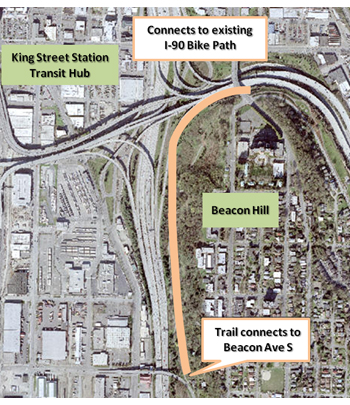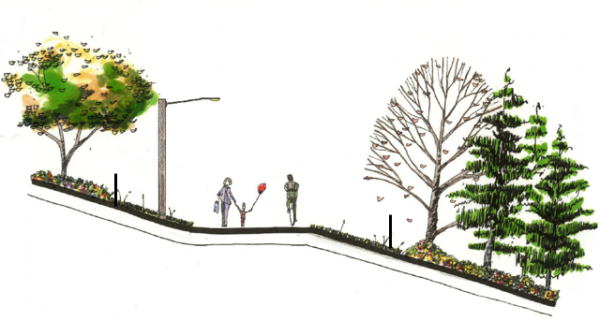 The under-construction extension of the Mountains-to-Sound Trail through Rizal Park and along the northwest slope of Beacon Hill will run through an unofficial homeless encampment that can get pretty rough. Unfortunately dubbed “the Jungle,” the steep-banked greenbelt has seen grisly murders and is notorious for drug use and troubled living.
The under-construction extension of the Mountains-to-Sound Trail through Rizal Park and along the northwest slope of Beacon Hill will run through an unofficial homeless encampment that can get pretty rough. Unfortunately dubbed “the Jungle,” the steep-banked greenbelt has seen grisly murders and is notorious for drug use and troubled living.
Lined with fences and well-lit, the 12-foot trail will run from the Jose Rizal Bridge where I-90 Trial currently ends to Beacon Ave S on the west side of the Hill. In addition to providing a far less-hilly way to travel between the west side of the hill to the Jose Rizal Bridge, the city hopes the trail will open up the green space to more city citizens and help to calm the area’s troubles.
People live in the Jungle for as many reasons as you can imagine. Life there can be hard, especially if WSDOT comes through unannounced and hauls everything you own to the dump. Several murders there remain unsolved, and officials have signaled their intent to clean the area up.
 “The upside for us is that it provides a solution to the jungle issue. We can take a space that previously was known for drug use and crime and convert it to a new public amenity,” SDOT spokesperson Rick Sheridan told KIRO.
“The upside for us is that it provides a solution to the jungle issue. We can take a space that previously was known for drug use and crime and convert it to a new public amenity,” SDOT spokesperson Rick Sheridan told KIRO.
A well-lit trail through the greenbelt will certainly change the space, but the KIRO reporter sticks with the safety angle and suggests the trail should be closed at night when it would be too dangerous to be in the area. I really hope the city is not considering doing that.
The Jungle is an urban space that can be very negative. This trail could be a chance to redefine the space. Driving out the homeless doesn’t need to be the goal, but creating a level of visibility that helps makes the space less inviting for dangerous and violent elements would be a good thing. Studies show that bike trails can bring lower crime, largely do to the increased visibility they bring.
In the meantime, the neighborhood will get a new way to acess green space and people riding bicycles will have a new way to get where they’re going. Sounds like a good community project to me. I hope fear does become an impediment to the trial’s success.








Comments
12 responses to “KIRO reporter concerned about MTS Trail extention through ‘the Jungle’”
Because the extension only extends through a partial section of The Jungle, I doubt it will improve the lower half south of Beacon Ave S.
Ever ridden the bike lanes on Capitol Hill’s 12th Ave. on a weekend evening? A crazy obstacle course of U-turning SUV drivers on phones, swinging car-doors, pedestrians standing in the street, La Spiga restaurant using the bike lane for it’s valet parking service, road construction signs, etc. The idea that cyclists’ safety would be at special risk on the MTS “jungle” segment is just silly. Please let me decide for myself whether it’s safe to ride on an off-street trail, rather than ask nanny govt to restrict my right to travel freely thru the city on my bike.
Just realized I didn’t phrase that well. I meant to direct my comments at the KIRO reporter who suggested the evening closure.
I appreciate the clarification – after all, the hazards you describe on 12th Ave / 12th Ave E are perpetrated by private individuals and businesses, not the “nanny state” (who, after all provides the roads and trails).
I know some turns of phrase are too delicious to pass up, but still…
I think Mike is drawing a parallel between the hazards posed by private individuals in both cases: violent crime vs. wacky road behavior. his criticism is directed at the idea that the “nanny state” would close the path to protect us from violent crime, but do nothing about the wackiness on 12th.
I’m with Mike — let me decide for myself where to ride at night.
Yes, Brian’s got it right.
How is the trail being funded? This comes up periodically with the Springwater Trail in Portland, but because it was built using federal transportation $$ it can’t be closed during evening hours.
It’s mostly WSDOT funding. I don’t know if there are federal funds in the mix, too, though.
Obviously care must be taken with dealing with strangers, but on several occasions I’ve been helped out by homeless guys. Twice they helped push start my van after I left the lights on all day. Once a guy helped me diagnose a busted set of points that left me by the side of the road, even gave me a small can of “starter fluid.”
But then I’m a guy, and I don’t take sh*t from anybody, but I’m willing to give them the shirt off my back if that’s what it takes.
And riding alone late at night can be eerie. I use a heap of lights and an air horn to startle people if need be. Most people won’t bother someone who has a retina burning light pointed at them.
It will be interesting to see how well-lit the trail actually is. This will be SDOT’s first lighted trail, and as with most of their efforts I doubt they’ll get it right the first time—and they certainly won’t care enough or have the budget to add extra lighting afterwards if they don’t. Even if light spacing and placement is good, they’re going with standard cobra streetlights because ped-scale lighting is expensive and easily vandalized. Sounds reasonable, but if they’re mounted high like standard streetlights, they’ll likely cast more shadows than light once the vegetation grows in. And of course the fences may make some users feel less safe since they can give the impression of being trapped. At the very least, they won’t offer much in the way of security: holes will be cut in the fences within days of installation.
Personally I can’t imagine this trail not feeling a bit creepy at night. I’d probably still ride through it, I sure as hell would never walk it after dark. But closing it at night is clearly an overreaction when the thing hasn’t even been completed. Let’s at least build it and see what happens. If people start getting raped and murdered left and right, we can always add gates later.
“we can always add gates later.”
We can always add police sting patrols and carry weapons. A few would be attempted robberies that go bad for the criminal are more than likely to slow that down.
However: I’ve walked the near unlit streets of Seattle at midnight and it isn’t the homeless who are the trouble. It’s the drunk guys spilling out of the bars looking for a fight. Homeless guys I run into are mostly trying to lay low and avoid going to jail. The less trouble with the law the better. They’ve got nothing but their freedom and they don’t want to lose that. Once it’s dark out, they tend to be hunkered down for the night.
If the trail is closed at night, then it is guaranteed to be dangerous at night.. and what happens at night will surely spill into the next day. If it’s left open at night, it could still remain dangerous.. or, the influx of riders might improve safety immensely. There’s really only one way to find out.
Trail lighting would help (especially for pedestrians), but riders who ride a lot at night probably have good lights anyways.